Mastering Wet Pro Skimboarding: Techniques and Gear
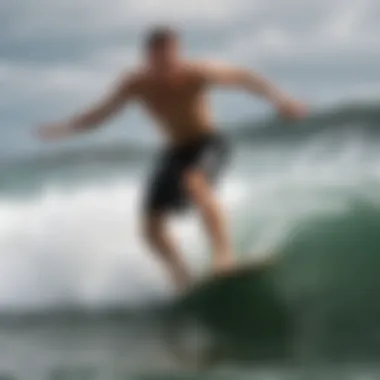

Intro
Skimboarding might not grab the headlines like some of its more glamorous counterparts in the world of water sports, but it's a unique blend of technique, creativity, and community spirit that captivates enthusiasts. The allure of slicing through the waves, gliding effortlessly on a skimboard, and tossing tricks in the salty air is simply magnetic. But, if you think skimboarding is just a free-for-all in the surf, think again. Particularly in wet conditions, mastering the art demands a nuanced understanding of various techniques, appropriate gear, and an awareness of safety.
Whether you're standing at the edge of the water, excited for your first skimboard session or you're an experienced rider ready to push your skills further, this article aims to illuminate every corner of wet pro skimboarding. We'll dive into the fundamental skills needed to thrive in the surf, discuss essential equipment to elevate your performance, and explore how to engage with the vibrant skimboarding community. There's a lot to unpack, so let’s get started!
Techniques and Skills
Fundamental Techniques for Beginners
For those dipping their toes into skimboarding for the first time, it's crucial to start with the basics. First off, learning to balance on the board while you're in the water is pivotal. Start in a shallow area where the waves gently lap at your feet. Stand on the skimboard with your feet shoulder-width apart, and keep your knees slightly bent. The key here is stability. Mastering this stance helps you prepare for any sudden movements that come from catching a wave or hitting the sand.
Once you feel comfortable, practice the art of running and dropping your skimboard into the water. It’s like the perfect dance; you need to time your drop with the wave.
Next comes the glide. Push off with your back foot, using momentum to launch yourself onto the board. Leveraging your body weight, keep your core engaged and lean slightly forward to ensure a seamless ride.
Tips for Beginners:
- Always warm up your body before hitting the water to prevent injuries.
- Choose a safe spot away from strong currents and other people.
- Watch and learn from experienced skimboarders; mimic their style and movements.
Advanced Skills for Experienced Athletes
Once you’ve honed your beginner techniques, it's time to add layers to your skillset. Advanced skimboarders can experiment with tricks that not only showcase their prowess but also harness the unique wave dynamics.
One popular trick is the kickflip. It requires adept timing and control. As you ride a wave, use your back foot to snap the tail of the board down while simultaneously pulling up on the front end, resulting in a flip. It takes practice, but once you nail it, it can elevate your performance significantly.
Moreover, learning how to perform aerials can impress spectators and enhance your overall riding style. This technique involves jumping off the wave and executing a trick mid-air before landing. Strengthening your core and leg muscles will be beneficial when tackling this skill.
Advanced Skill Considerations:
- Keep an eye out for wind conditions; light winds usually offer the best aerial performance.
- Focus on your landing; a controlled descent can help maintain momentum for the next wave.
Safety and Gear
Essential Safety Measures in Watersports
Engaging in skimboarding without considering safety is like diving into the ocean without a life preserver. Though it can be an exhilarating experience, maintaining safety is paramount. Here are some key considerations:
- Use padded helmets and proper footwear to avoid head injuries and foot mishaps.
- Familiarize yourself with local water conditions and hazards, such as rocks or strong currents.
- Always skimboard with a buddy, ensuring someone is around in case of emergencies.
As the saying goes, "better safe than sorry." Having basic first aid knowledge can be a lifesaver.
Gear Reviews and Recommendations
The gear you choose can make or break your skimboarding experience. A well-chosen skimboard can enhance your riding ability and comfort levels. Here are some recommendations:
- DB Skimboards - Classic Skimboard: Ideal for beginners, this board’s lightweight structure offers excellent buoyancy.
- Victoria Skimboards - Signature Pro Model: A popular choice for advanced riders with a solid grip and stability in challenging conditions.
Additionally, accessories like ankle leashes and quick-drying rash guards can contribute significantly to safety and comfort. An ankle leash keeps your board close while you’re in the water, preventing potential injuries and mishaps.
Understanding how to safely navigate the world of wet pro skimboarding while incorporating the right techniques and gear is critical. By focusing on skill development and safety, you'll not only enjoy the sport more but also inspire others to join the community. This active engagement fosters camaraderie among skimboarders at all levels, making the journey together all the more enriching.
Prolusion to Wet Pro Skimboarding
Wet pro skimboarding is more than a thrilling water sport; it’s a unique blend of skill, adrenaline, and community spirit. In this article, we will dive into the ins and outs of this dynamic activity, covering everything from essential techniques and gear selection to safety practices and community connections. For both newcomers and experienced skimboarders, understanding what wet pro skimboarding entails can not only enhance performance but also cultivate a deeper appreciation for the sport.
Defining Wet Pro Skimboarding
When talking about wet pro skimboarding, it’s essential to clarify what sets it apart from other skimboarding forms. Wet pro skimboarding primarily occurs in shallow waters, where enthusiasts can use a specially designed board to ride on the water’s surface after a wave crashes. Unlike dry skimboarding, where the focus is on flat, usually sand, surfaces, wet pro allows participants to harness the push of water for launch and tricks, creating a distinctive experience.
This type of skimboarding demands a good understanding of aquatic dynamics, as every slight change in water depth or wave height can significantly impact performance. Skimboarders navigate a balance of speed and agility, often requiring a broad range of skills, from basic maneuvering to intricate tricks. The engagement with water not only adds an exhilarating rush but also presents its own set of challenges, which makes mastering the sport a rewarding journey.
The Appeal of Wet Conditions
There’s an undeniable charm in skimming across the surface of the water, feeling droplets splash against your skin as you carve through waves. Wet conditions offer an environment that enhances both the thrill and creativity involved in the sport. Here are some reasons why enthusiasts are drawn to this aquatic adventure:
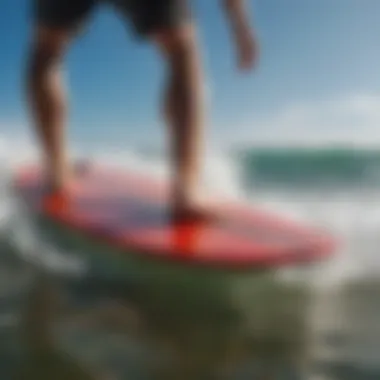
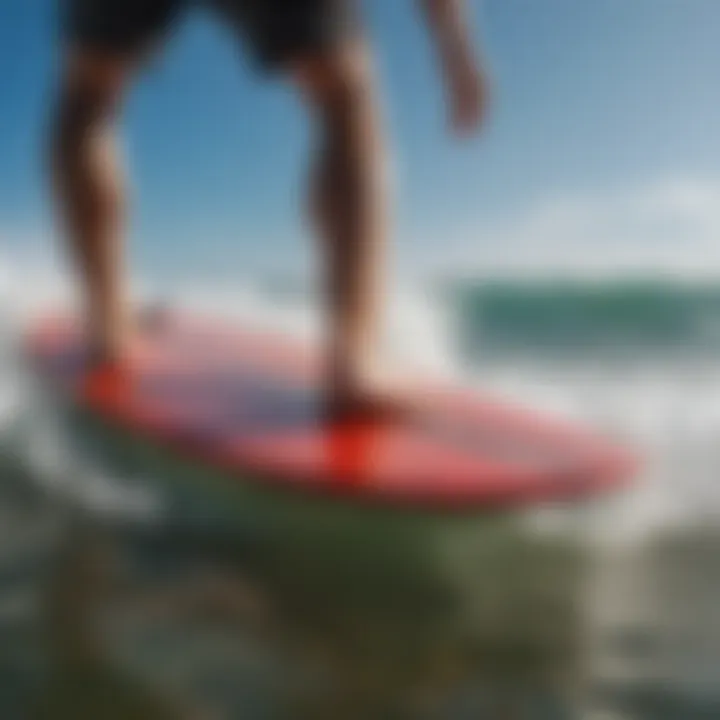
- Dynamic Environment: The ever-changing nature of water grants riders the opportunity to adapt and improvise. Each session is unique, shaped by sea and weather conditions.
- Skill Development: The challenge posed by wet conditions fosters a quick learning curve. Riders improve balance and coordination as they push their limits with various tricks.
- Community Vibe: Wet pro skimboarding often draws enthusiastic crowds. It creates a social atmosphere filled with shared tips, encouragement, and camaraderie among riders.
To put it bluntly, wet pro skimboarding is a playground for water lovers. It transforms the shoreline into an arena where skill meets nature, and individual expression thrives. As the excitement builds, so does the longing to connect with fellow enthusiasts, making this activity a pathway into a vibrant community.
"Skimboarding in wet conditions is like dancing with the ocean—each wave dictates a new step and style."
Understanding the Basics of Skimboarding
Before one leaps into the frothy waves on a skimboard, grasping some foundational knowledge about the sport is crucial. Understanding the basics establishes the groundwork for both beginners and seasoned enthusiasts, as skimboarding isn't just about gliding across the water; it's a nuanced activity that combines technique, timing, and sometimes, artistry. Knowing the sport's history, the differences between wet and dry conditions, and the skills required sets the stage for a more fulfilling experience.
History and Evolution
Skimboarding's roots can be traced back to the late 1920s, primarily on the beaches of California. Initially, it was a simple pastime where local surfers would use wooden planks to ride the shallow waves. With the passage of time, this activity morphd, influenced by surfing culture and advancements in materials.
Can you imagine? What started as a bit of fun in the sand transformed into a dedicated discipline, now boasting competitions and thriving communities. Early skimboards were clunky wooden planks that required great strength to maneuver, but advancements like foam materials and fiberglass have reshaped the experience. Armed with lightweight boards, riders have more control and can truly express themselves creatively. The tech has evolved, but the essence of skimboarding remained nostalgic, with a sense of freedom that continues to invoke excitement among beachgoers.
"Skimboarding is an art form disguised as a water sport."
Key Differences Between Wet and Dry Skimboarding
Skimboarding can be performed on both wet and dry surfaces, yet the techniques and experiences differ significantly. Understanding these distinctions is crucial when tailoring your approach.
- Surface Conditions: In dry skimboarding, riders often launch off a flat, dry sand surface. This type often allows for higher speeds and more extended tricks. Wet conditions, however, introduce an added dynamic; the moisture alters the board's interaction with the surface, allowing for smoother entries and exits into the water.
- Tricks and Techniques: The trick repertoire varies. Wet skimboarding opens up opportunities for tricks like slides, spins, and even early cutbacks that are nearly impossible in dry conditions. On the other hand, dry riders may focus more on jumps and flips.
- Safety Considerations: The risks associated can differ greatly as well. Wet conditions might lead to unexpected collapses or drops, posing a challenge to maintain balance. Dry skimboarding could be safer but comes with its own set of slips and falls. Each requires different methods of preparation and awareness, and understanding this can make all the difference.
Whether you're interested in the sport's legacy or eager to discover how wet and dry conditions affect performance, knowing the basics of skimboarding can not only enhance your skills but deepen your appreciation of this exhilarating sport.
Essential Techniques for Wet Pro Skimboarding
When diving into the nitty-gritty of wet pro skimboarding, the techniques you employ play a crucial role in shaping both your performance and enjoyment on the water. Mastering essential techniques can be the difference between gliding across the waves like a pro or wiping out embarrassingly. In this section, we will explore the foundational techniques that pave the way for not just improved skills, but also a deeper connection to the art of skimboarding in wet conditions.
Proper Stance and Balance
Achieving the right stance and maintaining balance is like finding your footing on a tightrope; it’s key to a smooth ride. Skimboarding in wet conditions can be slippery, requiring you to have your feet positioned correctly to maintain stability. Generally, your feet should be shoulder-width apart, with your knees slightly bent to absorb the unevenness of the water's surface. This helps in achieving a lower center of gravity, thereby enhancing your control during your ride.
One of the best techniques is to use a relaxed posture. Tension can work against you — think of it as being a reed in the wind rather than a stiff branch. When you adopt this relaxed stance, you allow for better responsiveness to sudden changes in the wave or surface, which can help avert mishaps. Maintaining focus is also vital; keep your eyes on where you want to go instead of getting distracted by what's happening around you.
"The best surfers aren’t just boarded on their skills; they listen to the waves, almost as if conversing with them."
Launching from the Shore
The launch is where your skimboarding journey begins, and it’s as important as the actual ride itself. Having a proper take-off means you can carve into the waves with confidence and grace.
To launch effectively, start by positioning your board at the water's edge, where the tide meets the sand. With a quick glance at how the water rolls, prepare yourself to sprint down the wet sand. Timing is everything here. You want to take off just as the water pulls back after a wave crashes, allowing you to leap onto your board with momentum.
Your foot should land squarely in the center of the board to maintain balance. A common mistake is to rush the launch; remember that ease and timing go hand-in-hand. Practicing the launch repeatedly will develop muscle memory, which will prove invaluable in the long run.
Executing Tricks in Wet Conditions
Now comes the fun part — tricks! Whether you're aiming to impress onlookers or just enjoy a solo moment of glory, executing tricks in wet conditions adds another layer of excitement. However, doing tricks isn’t just about flair; it requires skill, control, and a solid understanding of the conditions.
One effective strategy is to start with basic tricks like the shuvit or 180 spin, as these provide a solid foundation for more advanced moves. Focus on the board's rotation while ensuring your body weight is centered. For instance, when attempting a shuvit, your back foot plays a crucial role in snapping the board while your front foot helps guide its direction.
As water conditions change, keep adapting your approach; a heavier wave can alter the way your board floats and responds underfoot. Attentiveness to these nuances can prevent wipeouts and enhance your skill level.
Finally, don’t forget about recovery. If you fall, get back on quickly and try again. Reflection on what went wrong can often unveil the insight needed to improve.
With these techniques in mind, you’ll be equipped to dive into the thrilling world of wet pro skimboarding, relish each wave, and become part of a vibrant community that shares your passion.
Choosing the Right Gear for Skimboarding
Selecting the right gear for skimboarding is akin to a painter choosing the perfect brush. It can dramatically sway your experience and performance on the water. Without appropriate equipment, even the most skilled skimboarder can find themselves in a bit of a pickle. Therefore, understanding the ins and outs of gear selection is not just beneficial; it’s essential.
Material Considerations
When it comes to skimboard construction, the materials used play a massive role. Most skimboards are crafted from fiberglass, wood, or foam, each offering distinct characteristics.
- Fiberglass boards are known for their durability and light weight, allowing skimmers to accelerate quickly and perform tricks with ease. They're often favored in competitive environments.
- Wooden boards provide extra buoyancy, making them a solid choice for beginners. However, they can be a bit heavier.
- Foam boards are less common but great for those who value stability. Easy to maneuver, these boards are less rigid, which can be forgiving for novice riders.
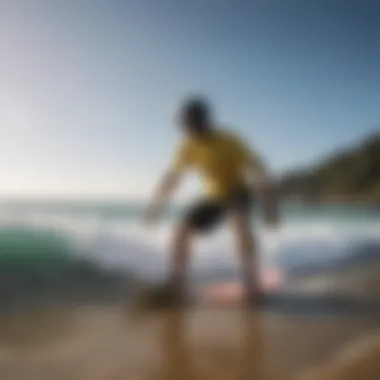
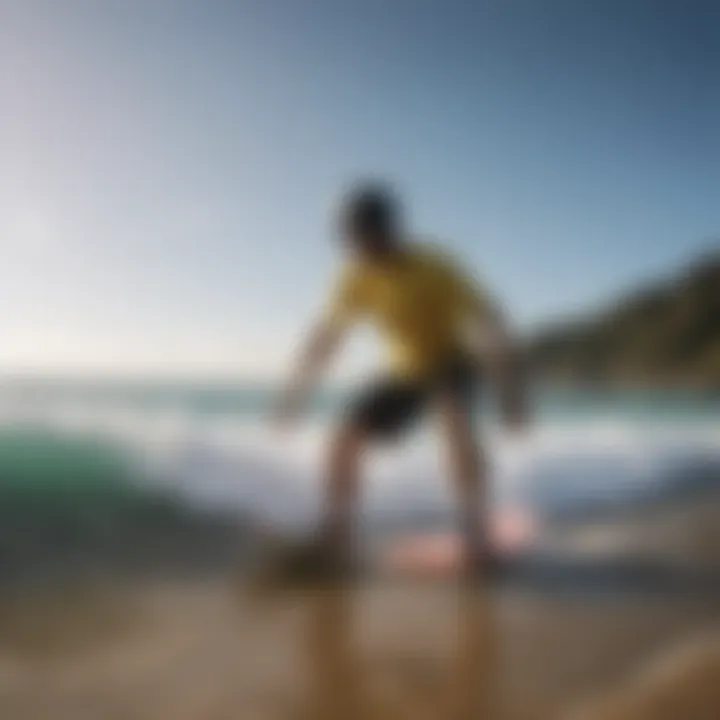
Each material has its perks, but the choice ultimately depends on your skill level and style. Like they say, "There's no one-size-fits-all here!"
Finding the Right Board Size
The size of the board is just as critical as the material used. A correctly sized board enhances control and boosts your comfort while riding.
- Height: Taller riders might prefer longer boards, while shorter individuals could benefit from compact options. A good rule of thumb is to aim for a board that reaches between your waist and chin when stood on its tail.
- Width: Wider boards offer better stability, especially for those new to the kick-it-on-the-beach lifestyle. On the flip side, narrower boards can allow for sharper turns.
Ultimately, figuring out your ideal board size can be a game-changer. Here’s a hint: don’t be shy! Try out varios options and trust your gut when it comes to comfort.
Footwear and Apparel
The right footwear and clothing can set you up for success in wet pro skimboarding. Below are some thoughts to keep in mind:
- Footwear: Opt for shoes that provide grip and comfort. Neoprene water shoes are popular since they dry quickly and offer good traction. Flip-flops might be stylish, but they can lead to slip-ups—think twice!
- Apparel: Choose lightweight and water-resistant clothes. Board shorts combined with a rash guard or a wetsuit can keep you agile without weighing you down. In cooler waters, a full wetsuit can keep the shivers at bay.
Selecting the right gear isn’t merely about checking off boxes; it’s an art that can make the difference between feeling like a pro or struggling to stay upright.
"The right gear leads not only to better performance but also to greater enjoyment in the surf and sand. Don't underestimate the power of well-chosen equipment!"
As you gear up for your next skimboard adventure, keep these considerations in mind. Ensure that each piece contributes to your overall experience, so you can focus less on the gear and more on having an unforgettable time out on the water.
Safety Practices in Wet Pro Skimboarding
Safety in wet pro skimboarding isn't just an afterthought; it's paramount to enjoying the sport while minimizing the risks involved. The hybrid nature of skimboarding—balancing the thrill of speed with the unpredictability of water conditions—necessitates a solid understanding of safety practices. Whether you’re a greenhorn or a seasoned rider, knowing how to keep yourself out of harm’s way can make all the difference. Let’s dig deeper into what keeps skimboarders safe in their watery playground.
Understanding Environmental Conditions
Before even hitting the waves, it’s essential to have a well-rounded grasp of the environmental conditions. The ocean can be fickle, changing its temperament with every tide. Here are some key factors to monitor:
- Tide Levels: Low tides offer a broad expanse, perfect for practice, while high tides may sweep you off your feet. Always check tide charts before heading out.
- Waves and Swell: Not all waves are created equal. Learn to identify the difference between a friendly wave and one that’s got some punch.
- Wind Patterns: Wind can play a huge role in water conditions. Strong gusts can create choppy waters, making it challenging to maintain your balance.
Understanding these environmental elements isn’t about getting scared; it’s about getting smart. Keeping an eye on the ocean’s mood can save you from unexpected wipeouts.
Choosing Safe Spots for Skimboarding
Finding the right place to skimboard can dramatically affect your overall experience and safety. Here are some considerations:
- Crowded Beaches: Avoid areas packed with swimmers or other water sport enthusiasts. A collision can lead to serious injury for you or someone else.
- Rocky Shorelines: Stay clear of places with visible rocks and debris. An unplanned encounter can lead to cuts, bruises, or worse.
- Signs of Rip Currents: Always be on the lookout for rip currents. These swiftly-moving channels can pull you under if you aren’t paying attention.
A good rule of thumb? Scout your location on a day without anyone else around. You’ll get a better sense of the lay of the land—or in this case, sea.
First Aid and Emergency Preparedness
Even with the best precautions, accidents can happen. So, it’s wise to equip yourself with first aid knowledge and supplies. Here are a few essentials:
- Basic First Aid Kit: A simple kit can go a long way. Include items like antiseptic wipes, adhesive bandages, and gauze.
- Learn CPR: It can be a life-saver, not just for you but for others in your group. Take a local class or find online resources.
- Emergency Contacts: Always keep a list of local emergency contacts in your pocket or a waterproof pouch. Knowing whom to call in a pinch makes a stressful situation less frantic.
“In the midst of chaos, there is also opportunity.”
This remembrance applies not just to skimboarding but to life’s many adventures. Having the foresight to prepare for emergencies can turn tides in your favor.
In summary, practicing safe habits in wet pro skimboarding goes a long way in ensuring both enjoyment and safety on the water. By keeping an eye on conditions, choosing spots wisely, and being prepared for emergencies, riders can enhance both their skills and their overall experience. Safety doesn’t just keep you out of trouble; it’s what makes the waves feel more inviting.
The Skimboarding Community
The skimboarding community plays an integral role in enhancing both the skills and enjoyment of the sport. It's not just about riding the waves; it's about connecting with like-minded individuals who share a passion for skimboarding and the ocean. The camaraderie found within this community offers many benefits, which can elevate one's experience from solitary to shared adventures filled with learning and growth.
Engaging with fellow skimboarders can lead to valuable exchanges of techniques and tips that might otherwise remain undiscovered. A seasoned rider might share a specific carving technique that has worked wonders for them, or a beginner might ask for advice on which board to choose. Such interactions can cultivate a sense of belonging, where even the most novice rider feels encouraged to pursue their aspirations and improve their skills.
The beauty of this community lies in its diversity. Riders come from different backgrounds, with varying levels of experience. Whether you’re a local looking to improve, or just visiting a popular skimboarding spot, the community often welcomes new faces. This inclusivity fosters an environment where everyone, regardless of their ability or knowledge, can find their place. A shared love for the sport bridges gaps, creating friendships that extend well beyond the beach.
"Surfing may be a solo sport, but skimboarding is truly a communal experience."
Connecting with Other Enthusiasts
Finding ways to connect with other skimboarding lovers is both exciting and essential for anyone looking to grow in the sport. Different platforms serve as excellent avenues for meeting fellow enthusiasts. Social media channels, particularly Reddit and Facebook, host groups focused on skimboarding where riders share tips, tricks, photos, and videos of their latest rides. These online communities often become a source of inspiration for new techniques that can be practiced on the sand.
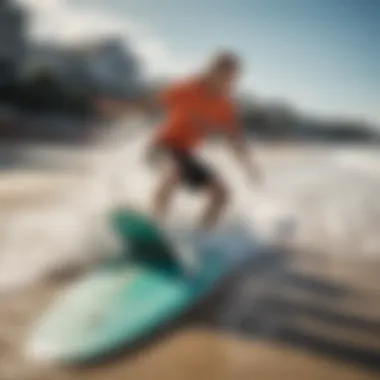
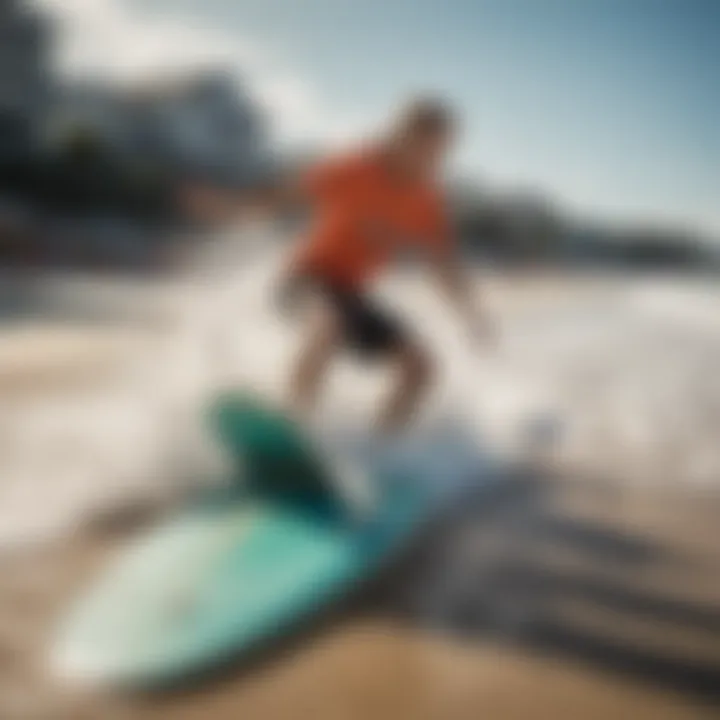
Moreover, local skimboarding clubs or organizations often organize meet-ups. These gatherings are not just about riding; they're also an opportunity to learn from advanced participants, try different boards, and engage in casual conversations about the sport. Exchange of ideas often occurs, where techniques turn into broader discussions about ocean safety, sustainable practices, or future trends in skimboarding.
Another excellent way to meet like-minded individuals is at local beaches. Just seeing someone setting up a skimboard can spark a conversation. Experience a relaxed approach, where you might even get to ride alongside someone who's willing to offer tips and mentor you a bit as you navigate the waves. Connecting face to face can be an enriching aspect that relationships formed online might lack, giving you not only skills but friendships that could last a lifetime.
Participating in Events and Competitions
Engagement in events and competitions can propel one's skills to new heights. Many coastal areas host regional skimboarding competitions that attract participants ranging from local heroes to seasoned professionals. This isn’t solely about competition; they also serve as a gathering for both spectators and participants to celebrate the sport, share experiences, and engage in a healthy contest of skill and technique.
Events typically welcome all skill levels, allowing newcomers to carve their path into the community. Competing at different levels, from local contests to national championships, can be intimidating, yet they foster a great learning environment. Watching others perform tricks and techniques can fuel your hunger to learn. Noticing how seasoned skimmers execute their moves in the water gives direct insight into various approaches—it's like a live tutorial right in front of you.
Moreover, participating in these events opens doors to potential sponsorships or mentoring from established riders. Vendors at these competitions display the latest gear innovations and even provide opportunities for test rides. There's nothing like the feeling of being part of an enthusiastic crowd, sharing in the highs and lows of the competition with other riders who understand the challenges and joys of the sport.
In essence, the skimboarding community isn’t just about riding; it's about growing together, taking lessons from one another, and embracing challenges as they come. Whether through connecting with others, attending events, or ongoing learning, the pathways are numerous for any passionate skimboarder.
Technological Advancements in Skimboarding
The world of skimboarding has seen a transformation in recent years, influenced heavily by advancements in technology. These innovations play a significant role in shaping the experience for both beginners and seasoned athletes. From materials to design, and from connectivity to gear efficiency, every small improvement adds to enhancing performance on the water and making the sport accessible to a wider audience.
Innovations in Board Design
One of the most notable changes in skimboarding is the evolution of board design. Gone are the days when every board looked somewhat similar. Now, you find a myriad of shapes, sizes, and materials available, each tailored for specific riding styles or conditions. For instance, some boards are crafted from high-density foam, giving them a lightweight advantage. This is particularly handy when launching into trickier sections of water.
- Hybrid Designs: A blend of traditional materials with modern technology allows for flexibility and robustness. Hybrid boards can withstand the rigorous wear and tear without compromising performance.
- Tail Shapes: Alterations to tail design, such as a swallow tail or a square tail, impact how the board interacts with water during tricks. Riders can pick based on whether they want a quick turn or more stability for jumps.
- Custom-Fit Options: Many companies are now offering the chance for riders to customize their boards, which is also a game changer. Having a board tailored to personal preferences can significantly enhance comfort and confidence on the water.
"In skimboarding, the right board not only reflects personal style but can elevate performance to new heights with the right innovations."
The Role of Social Media and Online Communities
Social media has become a vital force in popularizing skimboarding. Where once enthusiasts found local clubs, now they connect globally through various platforms. For many, this digital shift has provided inspiration and support, enabling them to learn from each other without the limitations of geography.
- Sharing Techniques: Platforms like Instagram and TikTok allow skimmers to post videos demonstrating tricks and techniques. This creates a vast pool of knowledge that newcomers can tap into.
- Building Communities: Facebook groups and Reddit forums, such as r/skimboarding, facilitate discussions, troubleshooting, and sharing experiences among enthusiasts with varied skill levels. This sense of community helps to foster belonging and encourages more participation in the sport.
- Event Promotion: Skimboarding events and competitions find a platform to reach broader audiences through social media, capturing the attention of potential new participants. These events often showcase the latest technologies and styles in action, drawing more people to the sport.
In summary, technological advancements in skimboarding are not simply about better gear; they also enhance community engagement and learning opportunities. As technology continues to evolve alongside social connectivity, we can only expect the art of skimboarding to expand its reach and complexity, inviting more thrill-seekers to join the waves.
Future Trends in Wet Pro Skimboarding
Understanding the future of wet pro skimboarding is crucial for enthusiasts keen on pushing the boundaries of this thrilling sport. As the landscape of watersports evolves, so too do the techniques and styles that define skimboarding. Knowing these trends helps practitioners stay ahead of the curve, enhancing their skills and extending their passion for the sport.
Emerging Styles and Techniques
The canvas of skimboarding is constantly being repainted with fresh styles and innovative techniques. Figures like Max McGuire and others are known for integrating surfing and skimboarding, creating hybrid moves that challenge traditional definitions.
- Pushing the Limits: Riders are experimenting with aerial tricks, revamping the way they approach wave usage. The goal fluctuations not just to skim but to soar above the surface, challenging gravity in ways that were once thought impossible.
- Inclusivity in Styles: Emerging styles cater to a broader audience. From the laid-back beachgoer to the competitive athlete, there's a technique that suits every level. This inclusivity encourages more people to join in, continuously breathing life into the sport.
- Board Innovations: Advances in materials lead to lighter, more durable boards that facilitate new tricks. For instance, boards with reduced weight offer skimmers the ability to manipulate their movements in the air better, allowing more ambitious trick execution without compromising stability.
The future will undoubtedly see more professionals willing to share their unique styles, spurring further creativity and innovation. The community's contributions are vital as they sculpt the evolving identity of wet pro skimboarding through collaborations, encouraging unofficial contests among local riders to test skills and techniques.
Sustainability in Watersports
Another vital trend reshaping the future of wet pro skimboarding is sustainability. The fight against environmental degradation has urged the skimboarding community to take significant strides towards eco-friendliness.
- Eco-Conscious Gear: Riders are increasingly opting for boards made from sustainable materials. Companies are now producing skimboards using recycled plastics or responsibly sourced wood, minimizing their carbon footprint and promoting environmental responsibility.
- Awareness Campaigns: The community actively participates in initiatives aimed at preserving coastal environments. Beach cleanups have become commonplace, with groups rallying to educate fellow enthusiasts about protecting delicately balanced ecosystems, ensuring that the beautiful spots we enjoy today can be visited by future generations.
- Responsible Behavior: Skimboarders today often embrace the ethos of leave no trace. By advocating for responsible use of beach spaces, they set a standard that highlights their commitment not just to the sport, but to the environment too.
As we look ahead, it's evident that developing sustainable practices is critical for the longevity of wet pro skimboarding. The community's proactive stance in shaping an eco-friendly future ensures that the sport remains viable, allowing future generations to enjoy the thrill of skimming without compromising environmental integrity.
The End: Embracing the Journey of Skimboarding
Skimboarding is more than just a pastime. It's a blend of skill, connection, and continually blossoming passion. The journey of wet pro skimboarding is one filled with learning, growth, and enjoyment. Each wave is an opportunity, and every skimboarder’s experience can be immensely different. Embracing this journey calls for understanding and appreciation of the many facets that make up the sport.
The Continuous Learning Process
Like catching waves, the path of learning never truly ends. Every session on the water teaches something new. Whether you’re just starting or have been skimboarding for years, there’s always room for improvement. Take, for instance, the nuances of different tricks or adapting to changing water conditions. It’s the small details that often make the most difference.
As skimboarders grow in ability, they tend to experiment with different styles or techniques. This trial-and-error approach can be exhilarating. One day you might master a new trick, and the next, you could find yourself falling unexpectedly. Each wipeout is a lesson. Remember to reflect on your experiences; this continuous feedback loop helps refine your skills and approach.
Peer interactions also play a critical role in this learning journey. Sharing knowledge with fellow skimboarders can enhance your understanding of the sport significantly. Join community groups, whether online like those on reddit.com or local meet-ups. There’s wisdom shared in conversations that plain old practice doesn’t quite cover. Finding a mentor or simply watching others can inspire innovation.
Encouragement to Explore the Waters
The world of skimboarding is vast, and exploring new waters can reignite your passion. Diverse locations bring different conditions, which can enhance not just your skills but also your enjoyment. Don't limit yourself to familiar shores. Take trips to different beaches or lakes. Sometimes, experiencing a different environment can be exactly what you need to unlock hidden potential.
Don't shy away from challenging yourself in unfamiliar settings either. Whether you find calmer waters or surf-heavy beaches, each new environment teaches resilience and adaptability. Be mindful of the varying tides and conditions, but this exploration is a critical component of the art of wet pro skimboarding.
Ultimately, the journey through skimboarding will mold your character. It’s about more than just the sport; it’s about the friendships forged, and the adventures taken. So grab your board, hit the waves, and enjoy every moment of this remarkable journey. Remember, each splash of water is a step towards mastery and connection in this vibrant community.















